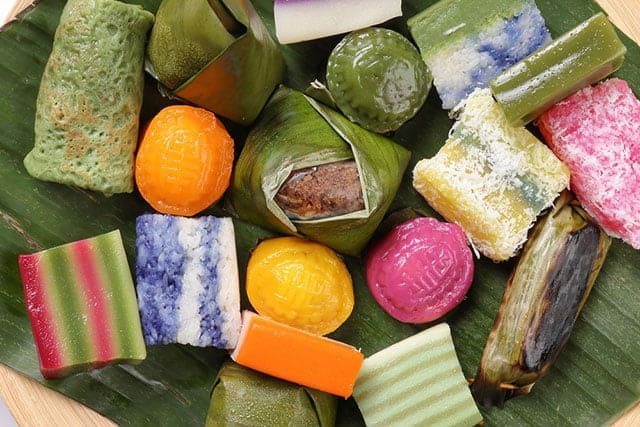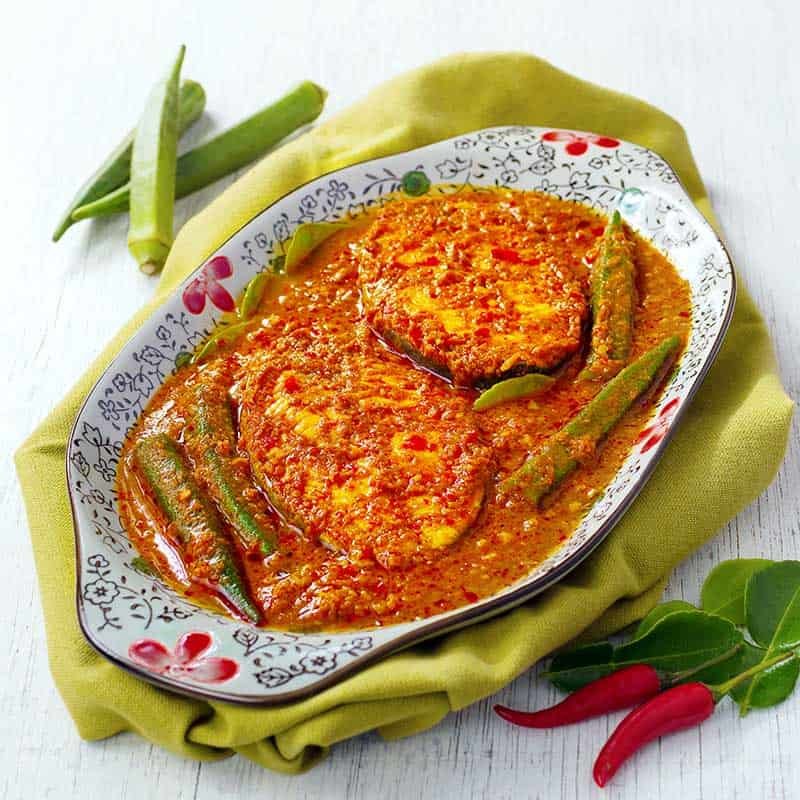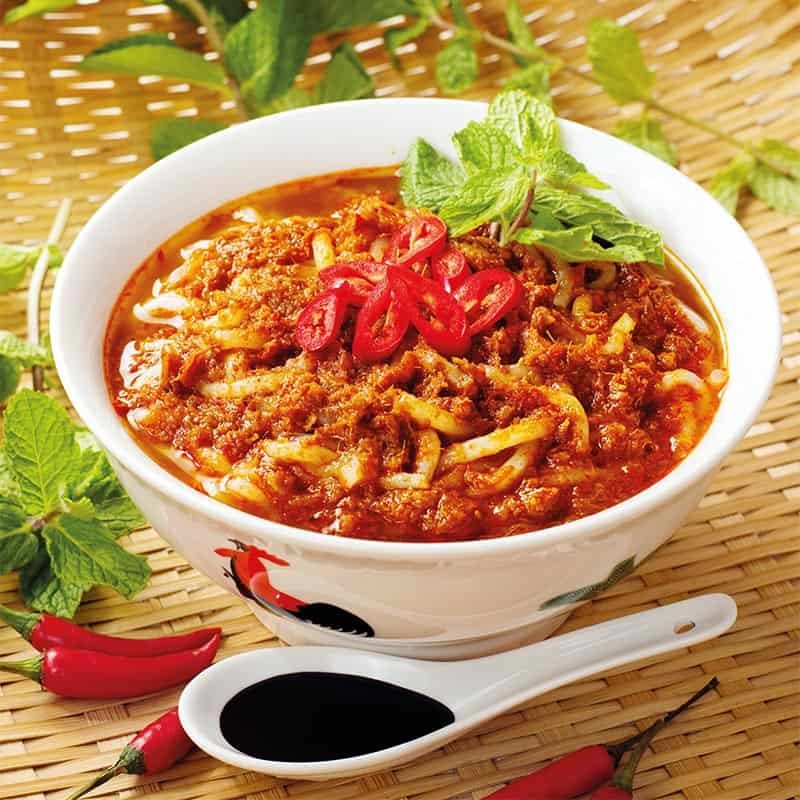Nyonya cuisine is a style of cooking that is extremely popular across Malaysia and is unique to that region of southeast Asia. We’ve talked about how continental immigration has helped shape the identity of Malaysian cuisine and Nyonya cuisine is a large part of this. For those new to Malaysian food, hearing mentions of food being referred to as “Nyonya”, or “Peranakan” can be confusing. After all, Malaysian cuisine can be characterised by a range of regional influences and cultures, so what is Nyona and where does it fit in amongst the eclectic range that consists of Malaysian cuisine? The Nyonya cooking style is the historical backbone of fusion Malaysian cuisine, the richness, aromatics, spice and intensity. In this article, we explore the origins, characteristics and significance of Nyonya cooking.
The history of “Nyonya”
Nyona cooking is a style of cooking created by the descendants of Chinese immigrants (known as “Peranakans”) who came to Malaysia in the 15th and 16th century. Many of these intrepid immigrants came to coastal towns such as Melaka, Singapore and Penang (which were affluent Portuguese and Dutch trading towns at the time) hoping to earn a good living. These mostly male Chinese immigrants began to mix and marry the local Malays. Crucially this had a big impact on both cultures’ cuisine as Chinese cooking techniques were combined with locally available Malay ingredients to create a unique and hybrid style of cooking. Over time this led to the creation of the ‘Baba Nyonya’ culture, a mingling of Malay customs and social practices with Chinese traditions and religious beliefs.
What is so Special about Nyonya Cooking?
As mentioned, the beauty of Nyonya dishes comes from the mixing of both Chinese cooking techniques and Malay ingredients. In particular, Nyonya cuisine is famous for the ‘Asam Pedas’ (sour spicy) flavour profile which can be found in many of the dishes. But what does this mean exactly? To understand the true identity of the Nyonya style, it’s important to understand where it’s characteristics come from.
Chinese Influences in Nyonya
An interesting fact about the Chinese influences in Nyonya/Peranakan cooking is that they are more focused on technique than ingredients from mainland China. While some Chinese ingredients do feature heavily in Nyonya food, Chinese immigrants in the 15th and 16th centuries did not have access to items to make authentic Chinese dishes. However, there were many key contributions.
Wok frying – The wide and curved radius of the wok means that heat radiates throughout the entire surface. This gives you a spacious evenly heated base to quickly fry and turn on. Fried dishes such as Cap Cai (a Nyonya stir-fried vegetable and meat dish) and Mee Siam (fried vermicelli) are examples of Nyonya dishes that are prepared using Chinese wok frying.
Black mushrooms – Various black fungus such as the ear mushroom has been used in Chinese medicine and cooking for thousands of years. Grown in the humid areas of southwestern China, these mushrooms are rich and earthy making them a perfect umami booster. Both Nyonya chap chye and Ayam Pong Tay both heavily feature these Chinese black mushrooms.
Tanghoon – Otherwise known as glass noodles, these potato starch noodles are used across most Chinese cooking styles either fried or boiled. Among many Nyonya dishes that include Tang Hoon is Kerabu, a tangy and spicy noodle salad dish served with ginger, kaffir lime leaves and lemongrass.
Taucheo – Originating from southeast China, this salted and fermented soybean paste is used to add body to Nyonyan sauces and stocks.
Malay Influences in Nyonya
Where Chinese immigrants were unable to recreate authentic homeland dishes in Malaysia, they simply started improvising with Malay ingredients which were available in abundance. Malay cuisine plays its part by giving Nyonya food a distinct aroma of spice, citrus and richness.
Lemongrass – A powerful citrus ingredient, lemongrass grows naturally in Malaysia’s sub-tropical climate and is used across many Nyonya dishes. One of the key dishes that use this pleasant smelling herb is Nyonyan shrimp in coconut milk.
Cloves – Providing a deep pungent spice, cloves are a key ingredient in many sauces.
Cinnamon – The sweet but rich spice of Cinnamon is used as the driving force for many curries and stews such as Babi Pongteh.
Cardamom – Spicy and sweet, cardamom pods are used to layer flavour into one of the most famous Nyonya dishes: thick beef Rendang.
Kaffir lime leaves – These leaves are used in just about every liquid-based Nyonya dish. They are bruised or torn before being infused into all types of curries, soups, sauces, stir-fries, dressings or stocks.
Coconut – As one of the most identifiable elements of Nyonya cooking, coconut milk is used to create a sweet creamy backdrop and level out the intensity of aromatic spice mixes. Beef Rendang uses simmered coconut milk, but it can also be used in desserts such as Bubur Cha Cha or with pandan leaves to make jam.
Lime juice – The use of Calamansi limes in Nyonya cooking is uniquely Malay and is a key ingredient in Sambal Belacan, a lively chilli sauce condiment that is very popular throughout Malaysia. Lime juice is also used in other Nyonya dishes such as Cincalok, and Balado.
Use of halal cooking practices – Religious customs of the majoritively Muslim ethnic Malay population would not have permitted the consumption of certain meats. This is why much ethnic Malay food uses fish and chicken as a primary source of meat.
Malay Influences in Nyonya
There are hundreds of Nyonya style dishes throughout Malaysia with numerous interpretations and modifications.
We have also developed a range of frozen cooking paste which you can find under Dapur Kitchen which offers you a super convenient way to cook many Nyonya and other Malaysian dishes. Our frozen pastes retain all the essential ingredients that can be hard to find, outside Malaysia especially. Most crucial for us is that these paste offer convenience whilst retaining all of the authentic flavours. This allows focusing cooking time on preparing and cooking the fresh ingredients for the rest of the dish.
Below lists a variety of classic Nyonya dishes, some of which are available under Dapur Kitchen.
Rendang
One of the most favoured curry dishes in Malaysia is the beef rendang. Using a combination of fried spices and coconut milk, beef is cooked over the course of a few hours until it is caramelised and infused with aromatics. Although originally a West Sumatran dish, beef rendang has been incorporated into Peranakan cooking practices with slight modifications in the way of spices, meats (eg. prawn, duck, crab or fish rendangs), and cooking techniques used. This dish is available as a concentrated paste under Dapur Kitchen.
Assam Fish
With Assam meaning ‘sour’ in Malay, this dish is another example of classic Nyonya cuisine combining those sour and spicy flavours. The traditional dish calls for ikan tenggiri (Spanish mackerel) or ikan pari (stingray) but can be cooked with whatever fish is at hand. Served with rice. This dish is available as a concentrated paste under Dapur Kitchen.
Nyonya Curry
A catch-all term to describe a variety of dishes with similar characteristics. Can be made with a variety of meat and seafood with some slight variation on the spices depending on a family’s interpretation. The key is a slow cook to extract the flavours from the meats. The flavour typically combines the classic sour and spicy flavours in a spicy stew that Malaysian’s love. This dish is available as a concentrated paste under Dapur Kitchen.
Laksa Lemak
Laksa Lemak is a much-loved Nyonyan favourite which includes vermicelli rice noodles that are served in a spicy aromatic curry sauce made from spices, chilli, stock and coconut milk. It is often served with prawns, tofu puffs, a hard-boiled egg, bean sprouts and a cilantro garnish. Laksa Lemak is a warming and comforting dish that fully embodies the Nyonya style – a Malay inspired curry sauce that’s hot, sour, sweet paired with Chinese glass noodles.
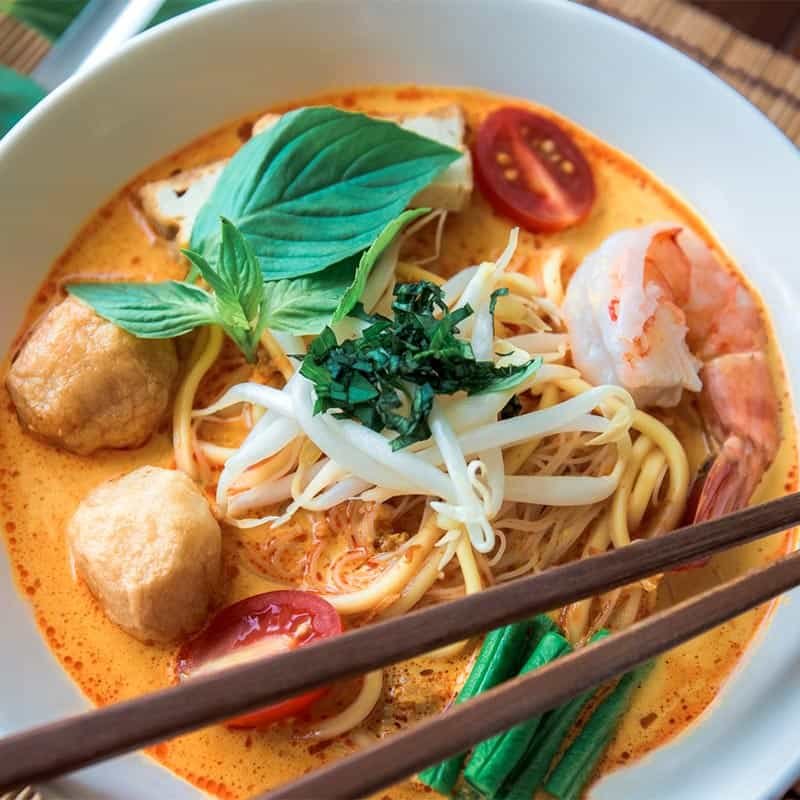
Asam Laksa
Like the Laksa Lemak, Asam Laksa is a noodle soup dish. However, where Laksa Lemak uses a curry base to drown its glass noodles, Laksa Lemak instead opts for a tangy, sour and spicy broth. Traditional Asam Laksa uses fish as the main source of protein, in particular the chub mackerel, although shrimp are also occasionally used. This is one of the most popular Nyonya dishes in Malaysia and is sold universally at every hawker stall, cafe and restaurant. This dish is available as a concentrated paste under Dapur Kitchen.
Choon Piah
The Choon Piah is a delicious Nyonya spring roll made from pastry, egg and stuffed with chopped up vegetables and crab meat. The spring roll is of an unmistakably Chinese origin that can be traced back to the southern province of Henan. Choon Piah is usually served with a dark, salty, sweet and sour sauce that contains chillies, soy sauce, lime juice and spices. There are countless variations of Choon Piah across Malaysia as it is easy to modify and customise to contents of the roll.
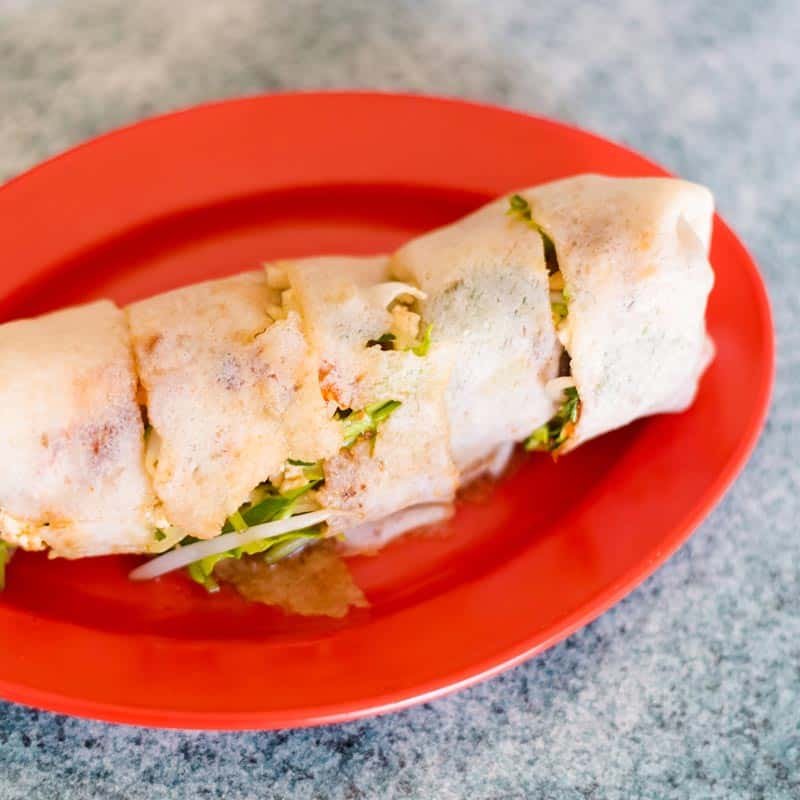
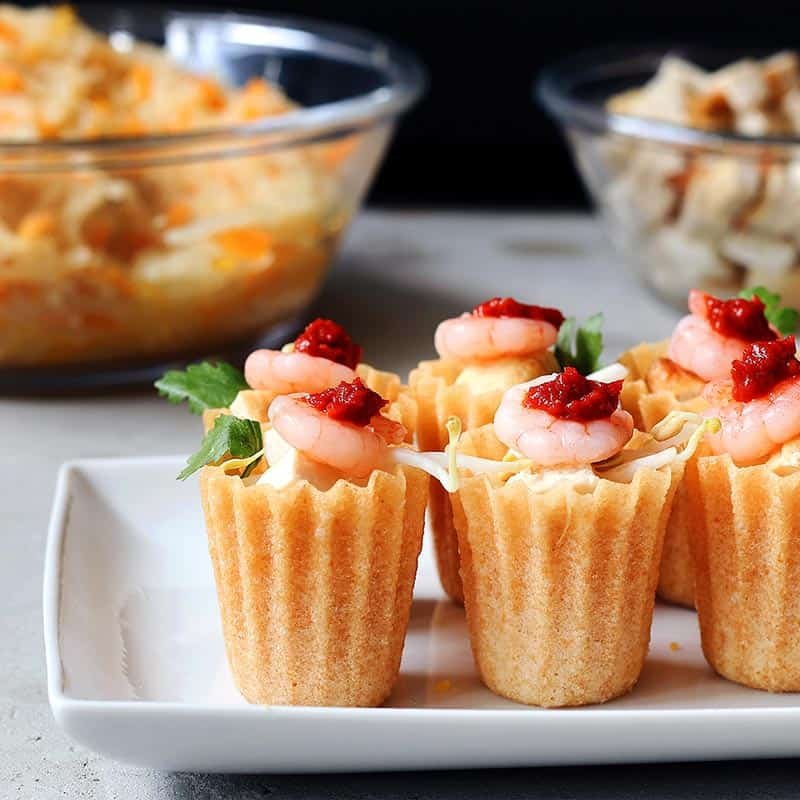
Pie Tee
Pie Tee or “Nyona top hats” are a widely popular Nyonan appetizer made from small pastry cups filled with diced prawn, cucumber, Jicama bean, shallots and shredded omelet. It’s a Peranakan finger food that delivers a wonderful crunch from the deep-fried shells and fresh vegetables. The flavour profile of Pie Tee is enhanced with chilli sambal which complements the freshness and crunchy texture with a fiery bite.
Jiu Hu Char
Jiu Hu Char is a stir fried dish made from shredded ingredients including jicama bean, carrots, cabbage, mushrooms and cuttlefish. Jiu Hu Char can be served as a side dish or can be wrapped in lettuce leaves as a light and healthy snack. Jiu Hu Char is most notably favoured on Chinese New Year by many Nyonyas across Malaysia and the wider region.
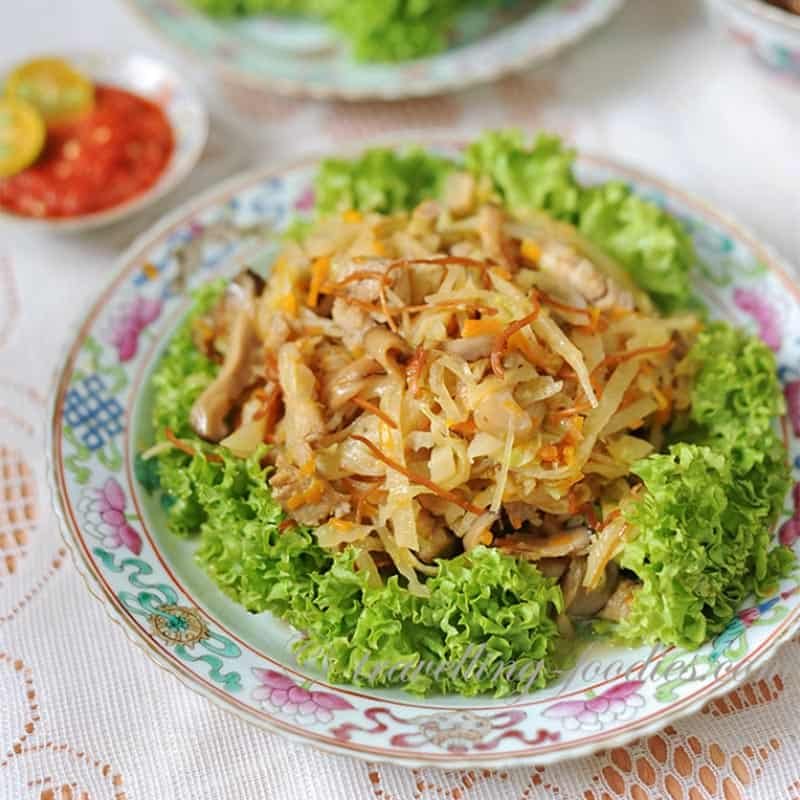
Nyonya Desserts
Desserts and sweet treats held just as much importance as savoury dishes in a traditional Nyonya wife’s cooking repertoire. Confectionary dishes play a key part in Malaysian Nyonya cooking as they are a good way of cleansing the palate after enjoying the intense flavours that characterise Malaysian Nyonya cooking. Key ingredients such as coconut milk, palm sugar and pandan provide a sweet creamy lightness that is refreshing and relieving.
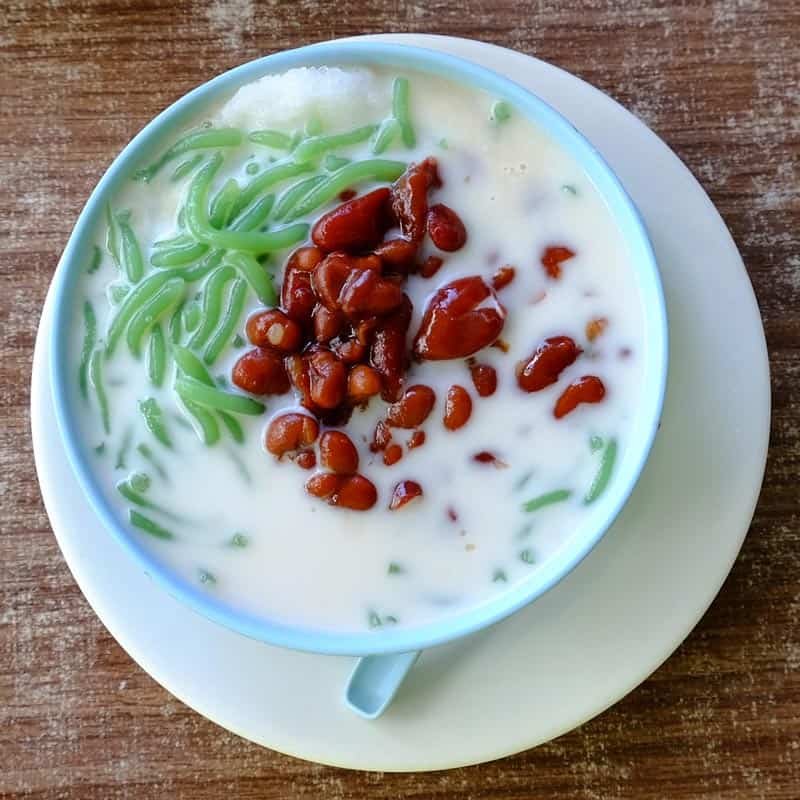
Cendol
Cendol is a cool dessert made up of layers of ice, coconut milk, sugar syrup and coloured jellies which are made from rice flour and pandan extract. It’s usually served in tall clear glasses which help to display the wonderful colours from the ingredients.
Onde Onde
Onde onde are balls of pandan infused rice gluten which are filled with a gooey palm sugar centre. These deliciously sweet treats are also caked in grated coconut before serving. This is one of Malaysia’s most loved “Kuih”, or sweet desserts.

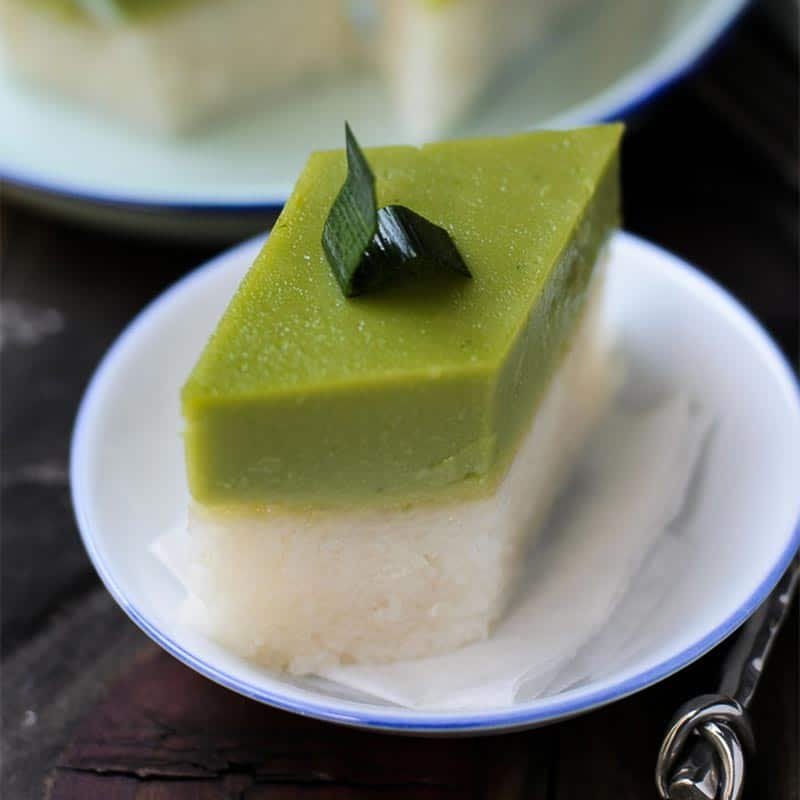
Seri Muka
This steamed cake is made from a base of glutinous rice overlayed with sweet coconut milk and green pandan custard. This Kuih is a well known Nyonya snack and is mainly enjoyed as an accompaniment to a cup of coffee or tea. Seri Muka is sold widely across many hawker stands and street cafes across Malaysia.
Over the years Nyonya cuisine has come to represent what is best about Malaysia, and what is possible when different cultures come together and share what they love with each other. However, this process is never static. Even today Nyonya cuisine continues to grow and develop as people around the world try and test out their own variations. It’s this spirit of openness and sharing of cultures that is what we’re all about at PA Food. And it is why we developed Dapur Kitchen, as an opportunity for people around the world to experience what authentic Nyonya cuisine is truly like.
Share :

